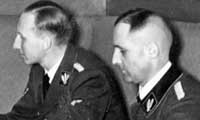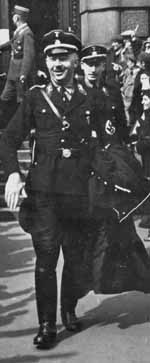| [Pictures added by this
website] Tuesday, February 27, 2001 New Questions
Arise on Fate of Gestapo Chief By HENRY WEINSTEIN,
Times Staff Writer For more than 50 years, Nazi
hunters and historians have tried in vain to
discover what happened to Gestapo chieftain
Heinrich Müller, who vanished in 1945
at the end of World War II. Of all the major Nazis,
Müller, who was Adolf
Eichmann's immediate
superior, is the most important still unaccounted
for, according to numerous Holocaust experts.
 Now,
efforts to solve the mystery are resurfacing,
including attempts to answer the most provocative
question of all: Was Müller briefly in U.S.
custody after the war? If so, did he escape, or was
he freed to become a CIA spy? Now,
efforts to solve the mystery are resurfacing,
including attempts to answer the most provocative
question of all: Was Müller briefly in U.S.
custody after the war? If so, did he escape, or was
he freed to become a CIA spy?
Müller is officially registered as dead in
Berlin. But his grave turned out to contain two
unknown soldiers when it was opened more than 30
years ago. His children subsequently removed the
headstone from the burial plot. U.S. Army Intelligence records indicate that
Müller -- who was nicknamed "Gestapo
Müller" to distinguish him from the hundreds
of other Müllers in the Nazi hierarchy -- was
captured by Americans in 1945, says historian
George Chalou, who worked at the National
Archives for 28 years. But what happened after that "is the $64
question," he said. According to sometimes contradictory
intelligence documents and media reports, over the
years Müller was "sighted" in East Germany,
Czechoslovakia, Switzerland, Brazil, Argentina,
Paraguay, Cairo, Damascus, Moscow, Washington,
D.C., and Portsmouth, N.H. In about a month, the National Archives plans to
release a 500-page Central Intelligence Agency file
on Müller, which may shed further light on his
postwar activities, according to Greg
Bradsher, a historian at the archives. So far,
the bulk of publicly available material on
Müller comes from U.S. Army Intelligence files
and material gathered by historians.  Müller
"has been the subject of interest for decades,
including to this day by my office," said Eli M.
Rosenbaum, head of the Office of Special
Investigations, the Justice Department's Nazi war
criminal unit, who believes it is possible that
Müller became a Soviet intelligence agent at
the end of World War II and scoffs at the idea that
he ever played a similar role for the United
States. Müller
"has been the subject of interest for decades,
including to this day by my office," said Eli M.
Rosenbaum, head of the Office of Special
Investigations, the Justice Department's Nazi war
criminal unit, who believes it is possible that
Müller became a Soviet intelligence agent at
the end of World War II and scoffs at the idea that
he ever played a similar role for the United
States.
The reason for Rosenbaum's interest is clear.
Müller rounded up thousands of Jews from the
Netherlands, Germany, Poland and Czechoslovakia to
be deported to Auschwitz
for extermination. In addition, one recently
released U.S. government document states that
Müller ordered the execution of prisoners at
Buchenwald,
a death camp near Weimar, Germany. "We've never given up" the hope of finding
Müller, "though it is now more a historical
question than a law enforcement question,"
Rosenbaum said. Müller, who was born in 1900,
is presumed to be dead. Last week, a German television network aired a
program -- based in part on documents from the U.S.
National Archives in Maryland -- claiming that
Müller was captured by the U.S. Army, but
released for unknown reasons. The program
speculated that Müller may have been employed
by a U.S. intelligence agency, but offered no
substantiation for that assertion. This weekend, Rabbi Marvin Hier,
dean of the Simon
Wiesenthal Center in Los Angeles, said if there is
any possibility that Müller played such a role
"the U.S. government should launch a formal
inquiry. There is an obligation to those who
suffered under the Gestapo." However, Rosenbaum, who reviewed the same
records, said "the conclusion that 'Gestapo'
Müller was apprehended by American authorities
and used by American intelligence is supported by
no credible evidence." Efraim Zuroff, who
runs the Wiesenthal Center's office in Israel, said
he thought it highly unlikely that the United
States would have used Müller after the
war.  "It
would be surprising if the Americans tried to use
someone of Müller's stature. . . . He was an
incredibly important player in the implementation
of the 'final solution' " -- Hitler's program to
exterminate the Jewish people, Zuroff said. "It
would be surprising if the Americans tried to use
someone of Müller's stature. . . . He was an
incredibly important player in the implementation
of the 'final solution' " -- Hitler's program to
exterminate the Jewish people, Zuroff said.
The veteran Nazi hunter said he thought it
probable that Müller, who was reportedly in
Hitler's
secret bunker the day before the Führer killed
himself on April 29, 1945, was killed at the end of
the war. But he quickly added, "I have no proof."
What happened to Müller remains "the big
question mark in terms of the perpetrators of the
Holocaust," Zuroff said from Jerusalem. Müller
was born in Munich, attended elem... He became a fighter pilot and was awarded
several medals. After the war, he joined the Munich
police force. In the late 1920s, he became the
Munich police's expert in the battle against
"leftist movements," according to the Encyclopedia
of the Holocaust. Müller became a key aide to
Reinhard Heydrich, the Bavarian police
chief. His reports on Communists brought him to the
attention of Heinrich
Himmler, who eventually became the second-
highest official in Nazi Germany. During the 1930s, Müller won a rapid series
of promotions in the SS, the German secret police
that served as the Nazi regime's principal tool of
terror, and his power continued to grow. He was one
of 15 people who participated in the January
1942 Wannsee conference, where the "final
solution" was planned. Within a few months, the first gas chamber camps
were set up in Poland, according to professor
Louis L. Snyder's Encyclopedia of the Third
Reich. Müller also played a key role in
investigating a plot by a group of German army
officers to kill Hitler in 1944 and remained loyal
to Hitler until the end, according to Holocaust
historians. Whether Müller lived past April
29, 1945, has been the subject of intense
speculation for years.  There
have been unconfirmed reports that he served as an
"enforcer" for former Nazis living in South America
and that he was kidnapped from Argentina in 1956 by
Czech agents. When famed Nazi hunter Simon
Wiesenthal issued a list of the 10 most wanted
former Nazis in 1987, Müller was on it. There
have been unconfirmed reports that he served as an
"enforcer" for former Nazis living in South America
and that he was kidnapped from Argentina in 1956 by
Czech agents. When famed Nazi hunter Simon
Wiesenthal issued a list of the 10 most wanted
former Nazis in 1987, Müller was on it.
In December 1999, the National Archives issued a
one-paragraph news
release stating that it was opening 135 pages
of files on Müller, primarily covering the
period from 1945 to 1963, but also including some
earlier Nazi government documents. The files contain tantalizing material,
including many items that contradict one another.
Despite the fact that the files were opened more
than 50 years after the end of World War II,
numerous portions have been redacted. In February 1999, eight months before the Army
records were made public by the National Archives,
Army officials sent Rabbi Hier a letter saying some
of his requests for information on Müller were
being denied on grounds of "national security,"
including the possibility that more complete
disclosure could compromise intelligence-gathering
methods. Among the materials the National Archives made
public are the following: - A December 1945 interview with a former Nazi
stating that Müller escaped from Berlin
through a secret underground passage that only
he and Eichmann knew about.
- A July 1946 Army Counter-Intelligence Corps
document saying "reports from the Russian zone
of Berlin seem to indicate" that Müller
shot and killed his wife and three children and
then himself, two days before Hitler died.
- Index cards stating that Müller was in
custody first in the town of Ilmenau and then in
December 1945 in a "civilian internment" camp in
Altenstadt in Upper Bavaria. The card does not
state what happened to Müller at
Altenstadt. It ends with the cryptic and
provocative sentence, "case closed 29 Jan 46."
It is unclear who placed the information on the
card, which states that a Müller dossier
was to be sent to Frankfurt.
- Another U.S. Army document dated July 11,
1946, states that British officials requested an
investigation of Müller in the Wurzburg
area, saying that it was believed he was dead.
But the document ends with: "results
negative."
- A 1951 document, saying an informant had
said Müller was in Czechoslovakia where he
"is supposedly directing intelligence activities
for the Soviets against the U.S. zone of
Germany."
- An August 1960 document saying Müller
was believed to be corresponding with
relatives.
- Numerous other documents from the 1950s and
early 1960s indicating the belief that
Müller was alive and that U.S. officials
were interested in finding him.
There are no new reports after 1963. Hier said
he hopes that the soon- to-be-released CIA files
will shed new light on Müller. Rosenbaum, who
has spent nearly two decades in the Justice
Department's Nazi war crimes unit, said he has
reviewed those files and they provide no definitive
answer. "If ever a Nazi just disappeared into the
mist, it was Müller," Rosenbaum said. "It's
one of the great unsolved mysteries of World War
II. The answer may be in Soviet files," he
said. Times Washington Bureau Chief Doyle
McManus contributed to this story.
Related
items on this website:
|